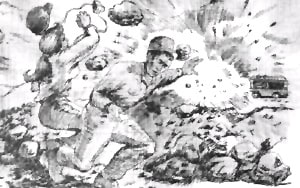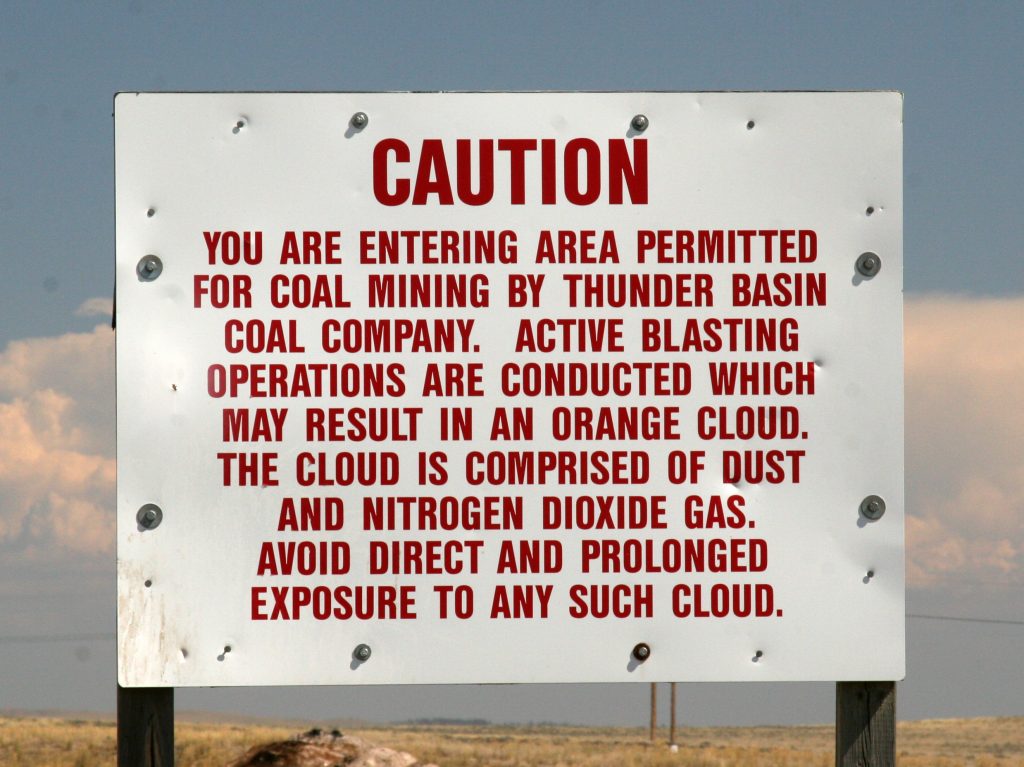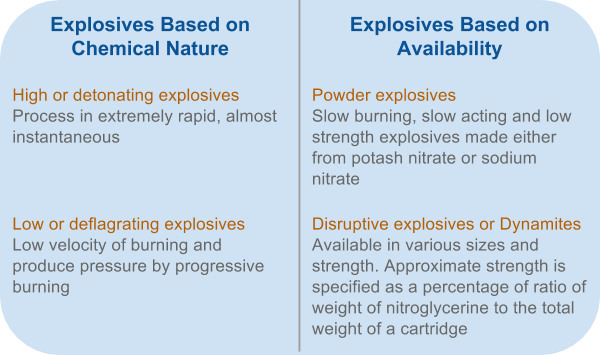Objectives
Upon completion of this lesson students should be able to:
- Describe types of explosives.
- Explain the basics of handling explosives.
- Explain the basics of toxic fumes.
- Demonstrate safe work procedures.
Reading & Lecture
Mine Blasting
Types of Explosives:
- Explosives based on chemical nature
- Explosives based on availability
Explosives
The most important responsibility of the blaster in charge is to prepare and fire safely. They are to practice safety in transportation, storage, handling, and the proper use of explosives.
Mine Explosives
- Black Powders (Early Times) – SN + Sulfur + Carbon
- Dynamite – NG + Wood Pulp (or SN)
- ANFO (Blasting Agents) – Ammonium Nitrate + Fuel Oil
- Water Gel, Slurry & Emulsion
- Detonators (Blasting Caps) – Electric, NONEL & Electronic
- Safety Fuses
- NONEL (Shock) Tubes
- Detonating Cords
- Primers & Boosters
Hazards in Use of Explosives
A. Transportation hazards
- The vehicle used to transport explosives should be in good operating condition. If the vehicle were to get a flat tire or lose its brakes It would lead to a serious hazard for everyone. The cargo space in which the explosives are stored should be of non-sparking material. If the vehicle got into an accident with damage to the cargo area, you would want to minimize any sparks that could set off the explosives.
- Detonators and explosives should be kept apart by at least four inches of hardwood, or transported separately. If a detonator were to accidentally fire this would prevent it from setting off any explosives.
- Explosives should be transported at times when the fewest number of people will be endangered. During shift change or before or after personnel are transported into or out of the mine is usually a good time to bring explosives into the mine.
- Explosives should not be stacked higher than the sideboards of the vehicle. If the vehicle were to hit a bump some boxes could fall off the side.
- No smoking is permitted on or near the vehicle. Hot ashes or flames pose a danger when mixed with powder.
- If ANFO or any other powder is spilled it should be immediately cleaned up.
- Do not ride on the cage when it is being used to transport explosive material.
- Vehicles should be driven carefully and excessive speeds should be avoided. Do not drive over unbridged power cables.
- Vehicles loaded with explosives should not drive into any maintenance area where sparks from welding or stray electric currents could set off explosives.
B. Detonator Hazards
- Do not let leg wires and detonators come into contact with electrical equipment, wires or rails. These may carry enough of a current to set off the charge.
- Caps can deteriorate and become more sensitive because of age. Caps may also become useless from such damage as being kinked, exposed to extreme heat, or contaminated with water. They should be properly disposed but only by experienced powdermen.
C. Magazine Hazards
- Magazines must be built in dry, isolated areas of the mine so as to be well ventilated, bullet-proof, locked, and have non-sparking material on the inside wall. It must be marked with a sign located in such a place that if a bullet were to be fired into it the bullet would not pass into the stored powder.
- Flammable materials such as fuel or oil should not be stored near a magazine.
- Smoking in and around a magazine is prohibited.
- Detonators and explosives should not be stored together in the same magazine. Separate magazines for them should be at least 25 feet apart.
- The magazine must be kept clean of ti ash, empty boxes, and paper at all times. They are both a fire hazard and a cause of slips and falls.
- No electric wiring or open lights should be taken into a magazine.
- Surplus or loose explosives should not be left in unsecured areas such as cuts, passes, or by the outside walls of the magazine.
D. Blasting Hazards
Misfires
A misfire is a loaded hole that fails to fire. The procedure following firing a round is that the blaster or supervisor will inspect the muck pile for misfires. No one else is permitted to enter the area until the all-clear signal is given.
- If the blaster finds a misfire he will attempt to re-wire and detonate it or flush it out of the drill hole with water and then dispose of it.
- After the blast the rock pile should be hosed down with water to keep the dust settled.
- In the event the misfire is completely covered by rock, the blaster may not see it. This results in a very dangerous situation. Do not attempt to move it yourself. If you discover a misfire in the rock, work should stop immediately, the area should be cleared and guarded, and the supervisor should be contacted.
- Toxic fumes may be found after detonation. You can avoid these fumes by remaining out of the blast area until ventilation dilutes the gases and carries them out of the mine.
- Carbon monoxide can be detected by observing one of the first symptoms of such poisoning – headache pain.
- Explosives containing nitroglycerine or other nitro compounds may burn rather than detonate. One gas resulting from this is nitrogen dioxide which is extremely dangerous to your lungs in small amounts. It has a burned powder odor.
- Wet ANFO will generate nitrous oxide fumes.
- After the blast the rock pile should be hosed down with water to keep the dust settled.
Overshooting
Overshooting results from either an excessive use of explosives, an improperly sized drill hole, or holes that are not properly placed according to the delay pattern. Undershooting is just the opposite. Overshooting weakens the remaining deposit making it susceptible to falls and may require use of supports. Undershooting results in an uneven face and creates haulage problems by having to move larger sized rocks.
Fly Rock
Fly rock consists of pieces of rock blown from the shot area by the explosive force. This rock can be lethal because of its , weight and velocity of travel. Flyrock is also caused by a blowout. When a blast hole is not drilled deep enough into the rock, the explosive force blows the rock out into the drift or work area.

Electrical Hazards
Electrical hazards are present if the mine uses electric blasting caps.
- Natural sources like static electricity or lightning storms.
- Man-made sources like stray electricity and radio transmitters.
- Only special galvanometers should be used to test continuity. Regular galvanometers may set off the charge. If you find a cap in the muck pile do not attempt to test the leg wires – only experienced powdermen are equipped to do such work.
- Any power equipment with leaking current presents a hazard.
- Static charge built up from pneumatic loading equipment.
Bootlegs
Never drill into a bootleg – it could contain a charge of powder that might detonate when struck by the drill steel. Prior checks of the hole may have accidentally not detected the powder, so do not take any shortcuts.
Safe Work Procedures with Explosives
Training
Task training is given to the powder crew to increase their technical skills in the use of explosives. Only experienced people trained in use of explosives or working under close supervision should work with explosives. All other miners should stay out of the way while the powder crew works unless assigned to the area.
Clearing the Blast Area
Clearing the blast area is very important. Unless the area is secured, other people may unknowingly walk into a life threatening situation from either the blast itself or the toxic fumes that follow the blast.
- The blasting crew will clear the area of all personnel, and then give a warning signal before setting of the round. Guards should be posted at all entrances to the area with specific instructions to keep everyone out. Guards should not leave their post even for a moment because someone could walk past without being seen. Guards must remain at their posts until specifically told to return to their regular work.
- Equipment should be moved clear of the blast area to prevent damage.
- Miners should stand clear of the blast area, such as behind equipment, to protect themselves from being hit by flyrock. Always give yourself enough room to stay clear.

Re-Entering the Blast Area
Before resumption of work, a supervisor or blaster will inspect the blast area for misfires and fumes. No one should enter this area past the guards until the all-clear signal is given by this person.
Reporting Undetonated or Misfired Explosives
Any miner who discovers an undetonated explosive near a magazine or along a haulageway, or a misfired explosive near their work area shall halt work, clear everyone out of the area and guard it, and notify a supervisor about the hazardous situation. Never attempt to move the explosive yourself because it may be very unstable and could go off in your hand.
Personal Protective Equipment
- Hard hat
- Safety Toed Shoes
- Reflective Vest
- Safety Glasses
- Gloves
- Hearing Protection



